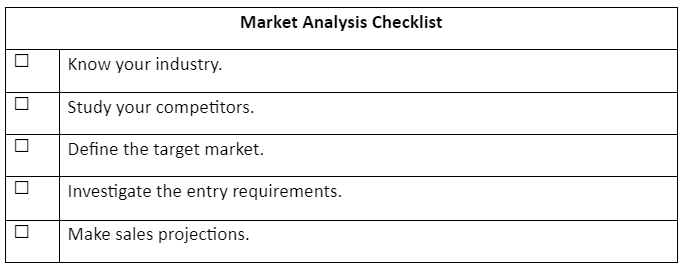This blog post will discuss market analysis, how to conduct market analysis, its advantages and disadvantages.
Every business endeavor ends in a market for the exchange of value. The market is the test of business viability. Product developers must keep the customer at the center of the development to pass the market test.
Many forces play in a market, and a business must compete, leverage, and differentiate itself for its survival. Business analysts must periodically scan the market environment when considering new products and expanding existing lines.
A business can ask the following questions:
- Is the market large enough to earn profit and grow?
- What will sell well in this market?
- Where is this trend headed?
Answers to these questions guide a business appropriately. Businesses want to avoid discovering red flags while entering a new market, launching new products, or updating existing ones.
What is a Market?
As mentioned, businesses’ endeavors end in the market for a return on investment. In a market, customers get goods or services and, in return, offer a means of exchange.
Markets can be described according to the buyers’ and sellers’ involvement. A market can be a monopoly (where the market has one seller and many buyers) or monopolistic competition (where the market has free entry and exit of sellers).
It is important to note that forces of demand and supply, government policy, etc., influence a market.
What is Market Analysis?
Market analysis is comprehensive market research, including an assessment of the behavior of potential customers, forces of a market, and attributes of a product’s target market to realize an opportunity or mitigate a threat.
It also includes competitive analysis for competitors or a competitive landscape.
Every business conducts market analysis periodically, as the market environment is dynamic and always changing.
Businesses must adapt to changing market conditions and demands. The market analysis provides data that includes revenue projection, market size/share, consumer preferences, buying motives, etc.
Please note that market analysis is different from market research. Market research studies a specific market segment, while market analysis focuses on the entire market.
How to Conduct Market Analysis
The following steps are required in conducting a market analysis:
Step 1: Understand the Industry
Understanding industry knowledge is vital, as no business exists in isolation.
The following questions can help understand the industry:
- What is the market’s size or value?
- What is the profit potential?
- What is the industry’s size and growth rate?
- What are the current market conditions?
- What is the competitor’s market share?
- How many potential consumers is the business looking at?
- How many similar businesses are in this location?
- How much are customers willing to pay for the solution?
- Are there operational standards for new entrants?
- Are there gaps to innovate around?
- What are the costs of building the business (e.g., product development, suppliers, technology, certification, patents, etc.)?
These are some reputable business data resources: the U.S. Census Bureau, the U.S. Bureau of Labor Statistics, state, local commerce sites, trade journals, etc.
Step 2: Study the Competitors
Businesses use Porter’s Five Forces of Competition for competitor analysis.
However, in the context of market analysis, consider the following:
- What are the bestselling brands in the market?
- What are their selling points or differentiating factors?
- How does the market respond to new product entrants?
- What is their pricing strategy, marketing strategy, and value proposition?
- In reviews of the highest-selling brands, are there any gaps that your product can leverage?
Market gaps consist of needs that are currently unmet by existing brands. They provide a space for new, different, and improved products. For example, mobile-phone manufacturers developed and incorporated a torchlight for users in power-deficient regions.
A business must identify these gaps. Most improvements result from a gap identification.
You can conduct a SWOT analysis of your strength and weaknesses against your competitor and identify opportunities and threats to your business.
Step 3: Define the Target Market
The market can be huge; the business must define the target segment.
The following questions can help define the target market:
- Which market segment can the business effectively target to sell its products or services?
- Who are the customers? What are their needs?
- Which demographics define this market segment (e.g., gender, age, income, location, language, preferences, lifestyle, culture, bias, buying patterns, etc.)?
- Which pain points exist in this target market segment?
- Which features and functionalities of the product or service will address or ease these pain points and win customer loyalty?
- Which marketing strategies will persuade the target market to try the product or service?
Step 4: Investigate the Entry Requirements
Every market has formal and informal protocols.
Some requirements may include:
- Proprietary: Does the business need a permit to use a particular type of technology or feature?
- Legal: What is the venture’s legal status? Is the business operating within the law?
- Political: Are there any internal or external political factors to address before delving into the market?
- Fiscal (Taxes): What are the tax laws for this type of business? Are there tax incentives for new entrants?
- Investment/“Sunk” Fund: How much will the business need to invest (e.g., into advertising, product development, marketing, or distribution)?
Step 5: Make Sales Projections
Sales forecasts or projections estimate future sales so that you can make confident business decisions or secure funding from investors and lenders.
Businesses use sales projections to understand the potential profit.
They are looking at:
- How many units are expected to sell within this period?
- At what rate will the business sell per unit?
- Does the business have a sales promotion in view?
- What is the cost of production per unit?
- What is the advertising cost per unit?

What Are the Benefits of Marketing Analysis?
Marketing analysis helps businesses make informed decisions and achieve their objectives.
Some benefits of marketing analysis are as follows:
- Understanding Customers: Marketing analysis helps businesses understand their customers. They can identify their customers’ needs, preferences, and behavior, then effectively tailor products or services to meet their customers’ demands.
- Getting Investors’ Funding: Businesses can show the market analysis to their potential investors to get their funding for new business opportunities or business expansions.
- Identifying Market Opportunities: Businesses can uncover new growth opportunities by analyzing the market. They can identify untapped customer segments, emerging trends, or gaps in the market, which can be leveraged to gain a competitive advantage.
- Evaluating the Competition: Marketing analysis helps businesses analyze competitors’ strengths, weaknesses, and strategies, so they can develop counteroffers to stand out.
- Optimizing Marketing Efforts: Businesses can assess the effectiveness of their marketing campaigns and allocate resources efficiently by focusing on the strategies and channels that offer the best results and maximize their return on investment.
- Enhancing Product Development: By analyzing customer feedback, market trends, and competitors’ offerings, businesses can gather insights to improve existing products or develop new ones. This ensures that the offerings align with customers’ expectations and remain competitive.
- Mitigating Risks: Marketing analysis helps businesses assess potential risks and challenges that may affect them. By identifying these risks in advance, businesses can develop contingency plans and make informed decisions to minimize these risks’ impact on their operations.
- Monitoring Success: Regular analysis allows businesses to track their marketing efforts and measure their success. They can establish key performance indicators (KPIs) and benchmarks to evaluate their progress over time, thus allowing them to make adjustments and achieve their business goals.
What Are the Drawbacks of Marketing Analysis?
A few drawbacks of running a marketing analysis are as follows:
- Time and Resources: Marketing analysis requires time, effort, and resources. It involves collecting data, conducting research, and analyzing information. Small businesses may struggle to allocate the time and budget for comprehensive analysis.
- Complexity: Marketing analysis can be complex—especially when dealing with large data or using advanced analytical tools. It may require data analysis expertise or professional help. Complexity can pose a barrier for businesses that do not have knowledge of or access to specialized skills.
- Cost: Marketing analysis can be costly. The expenses that are incurred when purchasing advanced tools and/or software or hiring specialized professionals are not feasible for every business. Businesses should weigh the cost of marketing analysis against its potential benefits, as well as their budget.
- Prediction Limitations: While marketing analysis can provide valuable insights, it is also important to note that predictions based on this analysis are not always 100% accurate. Market conditions, consumer behavior, and other external factors can change over time, thus impacting the reliability of long-term predictions.
- Data Overreliance: Relying solely on marketing analysis without considering other factors (e.g., intuition, creativity, or qualitative insights) can limit the decision-making process. Analysis should be used alongside other input to make well-rounded and informed decisions.
Market Analysis vs Conjoint Analysis vs Sentiment Analysis
Market Analysis
Market analysis studies and examines market conditions, trends, and customer behavior to understand the market dynamics. It gathers information about customers, competitors, and industry to make informed business decisions.
Market analysis is a key component of a business plan. It helps businesses identify opportunities, evaluate the competition, and develop effective marketing strategies.
Conjoint Analysis
Conjoint analysis is a research technique to understand customers’ choices and preferences for different product attributes. It involves presenting customers with various product options and asking them to rank or rate their preferences.
By analyzing these responses, businesses can determine the relative importance of different product features and optimize their offerings. Conjoint analysis helps in pricing decisions, new product development, and understanding customer preferences.
Sentiment Analysis
Sentiment analysis, or opinion mining, analyzes and extracts opinions, emotions, and sentiments from textual data, such as customer reviews, social media posts, or survey responses. It uses natural language processing and machine learning algorithms to classify the sentiment as positive, negative, or neutral.
Sentiment analysis helps businesses measure customer sentiment towards their brand, products, or services, enabling them to understand customer feedback, identify areas for improvement, and manage their reputation.
The market analysis focuses on understanding the overall market landscape and customer behavior, while conjoint analysis delves into customers’ preferences for different product attributes. On the other hand, sentiment analysis deals with extracting and understanding the sentiments and opinions expressed in textual data.
Each analysis serves a different purpose but can collectively provide valuable insights for businesses to make informed decisions and improve their offerings.
Conclusion
Marketing analysis is an interesting business concept that can be a guidepost in making informed business decisions. It must be carried out professionally by experts. The return may outweigh the cost of hiring an expert analyst for a detailed investigation.
